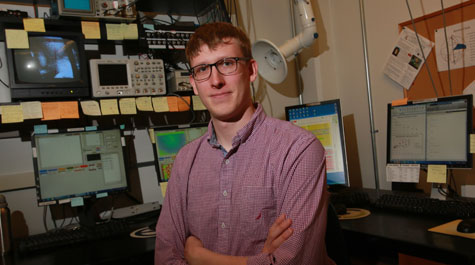Ultra-cold atoms deliver cool research
For Charles Fancher, saying that physics is cool is an understatement. “I was hooked from the moment I took my first physics class in my sophomore year of high school,” he said.
Today, Fancher’s research as a Ph.D. student in physics at William & Mary isn’t just cool; it’s ultra-cold. Fancher is part of a team of mostly graduate students led by Associate Professor of Physics Seth Aubin who’ve been making ultra-cold atoms a hot topic among physicists for years. Ultra-cold atoms – or atoms cooled to around 1 microkelvin, just a smidge warmer than absolute zero – are essential for advancing technology around things like atomic clocks, interferometers, or inertial navigation systems.
“If you want to measure something precisely, the best way to do that is with ultra-cold atoms,” said Fancher. “They’re useful for a range of science experiments, but could also significantly improve the accuracy of things like GPS satellites.”
They’re a rare – and recent – find, first achieved by Aubin and his team in 2012. But cooling them off is just the beginning. Now, Fancher and his colleagues are developing a way to trap and manipulate atoms, allowing more control over them and potentially opening the door for more advanced levels of atomic precision.
Fancher’s ongoing research on the topic was recently honored with the Northrop Grumman Corporation Award for Excellence in Scholarship in the Natural and Computational Sciences. His work will be celebrated at a luncheon at the 15th annual Graduate Research Symposium on March 19.
The breakthrough came after years of prep and experimentation with an atom chip the size of a Saltine cracker and a force generated by a theory called the AC Zeeman effect. The process starts with laser cooling, where several hundred million Rubidium-87 atoms are exposed to six lasers with a specialized frequency, allowing the atoms to absorb and emit the light 27 nanoseconds later.
“The atoms are absorbing something with less energy, and each time they do that they emit more energy than they absorb,” said Fancher. “This ultimately slows them down.”
It also chills them to a temperature of about 100 microkelvin, at which point they’re transferred to the atom chip to evaporate and cool the rest of the way. This leaves, ultimately, just a few tens of thousands of atoms trapped. “It sort of works like a cup of coffee,” said Fancher. “If you put it down and take the lid off, the hottest water molecules will escape and the rest of your cup gets colder. We do this process over and over until only the coldest atoms are left.”
That’s where the AC Zeeman effect comes in. The effect theorizes that if you apply an oscillating magnetic field to atoms that is created by an alternating current (or, an electric charge that periodically reverses direction), you can change their energy levels. It’s a way to spatially manipulate atoms and eliminate or separate spin states to create environments useful for conducting new experiments that could advance technologies for things like the inertial navigation system, which measures position, orientation, and velocity to predict where a moving object will be in the future.
While the theory had been tested with ultra-cold atoms in the past, microwave power from macroscopic microwave cavities was too weak to constrain the atoms in one place. Combined with the atom chip, which keeps the atoms compressed at just 100 micrometers away from the chip’s wires, the AC Zeeman effect proved successful in pushing and pulling the atoms to a desired location.
“Microwaves produced by an atom chip are predicted to enable forces stronger than gravity and make the system smaller, lighter, and require much less power,” said Fancher.
Fancher plans to expand on this work in the future by creating an atom trap using only the AC Zeeman effect. “We’ll have to build more microwave equipment but we should be able to use our current system and our current chip,” he said. “And that’ll be money-saving, time-saving, and overall more efficient.”
 Skip to main content
Skip to main content

